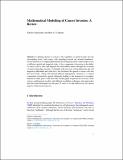Files in this item
Mathematical modelling of cancer invasion : a review
Item metadata
| dc.contributor.author | Sfakianakis, Nikolaos | |
| dc.contributor.author | Chaplain, Mark | |
| dc.contributor.editor | Suzuki, Takashi | |
| dc.contributor.editor | Poignard, Clair | |
| dc.contributor.editor | Chaplain, Mark | |
| dc.contributor.editor | Quaranta, Vito | |
| dc.date.accessioned | 2022-08-21T23:36:45Z | |
| dc.date.available | 2022-08-21T23:36:45Z | |
| dc.date.issued | 2021 | |
| dc.identifier | 276114182 | |
| dc.identifier | 9743ddcd-cf1d-4f6a-928e-1efe2efc28d0 | |
| dc.identifier | 85115175218 | |
| dc.identifier.citation | Sfakianakis , N & Chaplain , M 2021 , Mathematical modelling of cancer invasion : a review . in T Suzuki , C Poignard , M Chaplain & V Quaranta (eds) , Methods of Mathematical Oncology : Fusion of Mathematics and Biology, Osaka, Japan, October 26–28, 2020 . Springer Proceedings in Mathematics & Statistics , vol. 370 , Springer , Singapore , pp. 153-172 , International Conference by Center for Mathematical Modeling and Data Science , Japan , 26/10/20 . https://doi.org/10.1007/978-981-16-4866-3_10 | en |
| dc.identifier.citation | conference | en |
| dc.identifier.isbn | 9789811648656 | |
| dc.identifier.isbn | 9789811648663 | |
| dc.identifier.issn | 2194-1017 | |
| dc.identifier.other | RIS: urn:48B5BFDD012F4AFB10809DA22D3FC53B | |
| dc.identifier.other | RIS: 10.1007/978-981-16-4866-3_10 | |
| dc.identifier.other | ORCID: /0000-0001-5727-2160/work/100901541 | |
| dc.identifier.other | ORCID: /0000-0002-2675-6338/work/100901614 | |
| dc.identifier.uri | https://hdl.handle.net/10023/25867 | |
| dc.description | Funding: MAJC gratefully acknowledges the support of EPSRC Grant No. EP/S030875/1 (EPSRC SofTMech∧MP Centre-to-Centre Award). | en |
| dc.description.abstract | A defining feature of cancer is the capability to spread locally into the surrounding tissue, with cancer cells spreading beyond any normal boundaries. Cancer invasion is a complex phenomenon involving many inter-connected processes at different spatial and temporal scales. A key component of invasion is the ability of cancer cells to alter and degrade the extracellular matrix through the secretion of matrix-degrading enzymes. Combined with excessive cell proliferation and cell migration (individual and collective), this facilitates the spread of cancer cells into the local tissue. Along with tumour-induced angiogenesis, invasion is a critical component of metastatic spread, ultimately leading to the formation of secondary tumours in other parts of the host body. In this paper we present an overview of the various mathematical models and different modelling techniques and approaches that have been developed over the past 25 years or so and which focus on various aspects of the invasive process. | |
| dc.format.extent | 20 | |
| dc.format.extent | 237988 | |
| dc.language.iso | eng | |
| dc.publisher | Springer | |
| dc.relation.ispartof | Methods of Mathematical Oncology | en |
| dc.relation.ispartofseries | Springer Proceedings in Mathematics & Statistics | en |
| dc.subject | QA Mathematics | en |
| dc.subject | QH301 Biology | en |
| dc.subject | RC0254 Neoplasms. Tumors. Oncology (including Cancer) | en |
| dc.subject | T-NDAS | en |
| dc.subject | SDG 3 - Good Health and Well-being | en |
| dc.subject | AC | en |
| dc.subject.lcc | QA | en |
| dc.subject.lcc | QH301 | en |
| dc.subject.lcc | RC0254 | en |
| dc.title | Mathematical modelling of cancer invasion : a review | en |
| dc.type | Conference item | en |
| dc.contributor.sponsor | EPSRC | en |
| dc.contributor.institution | University of St Andrews. Applied Mathematics | en |
| dc.contributor.institution | University of St Andrews. School of Mathematics and Statistics | en |
| dc.identifier.doi | 10.1007/978-981-16-4866-3_10 | |
| dc.date.embargoedUntil | 2022-08-22 | |
| dc.identifier.grantnumber | EP/S030875/1 | en |
This item appears in the following Collection(s)
Items in the St Andrews Research Repository are protected by copyright, with all rights reserved, unless otherwise indicated.

